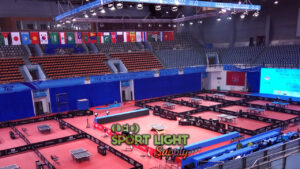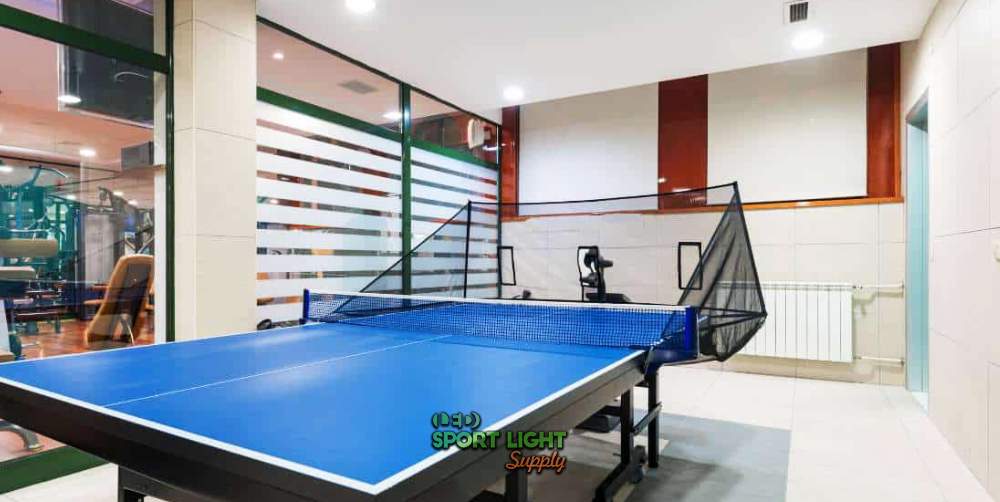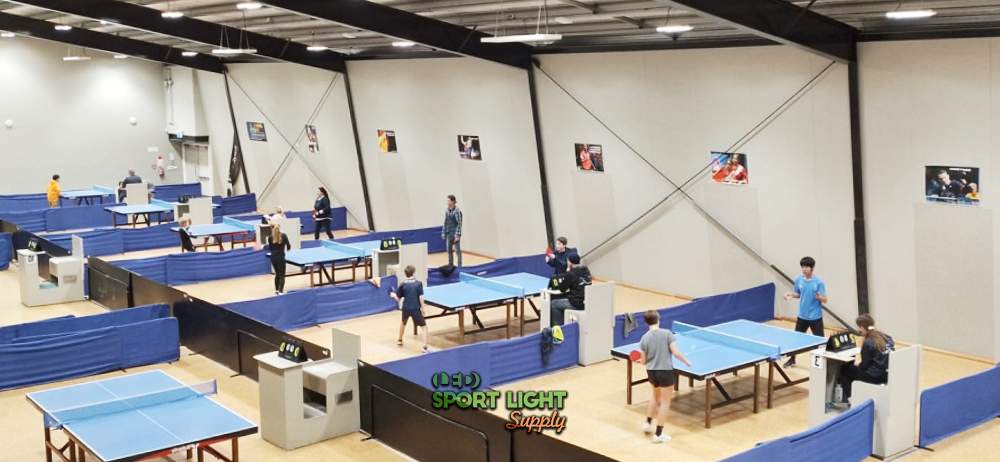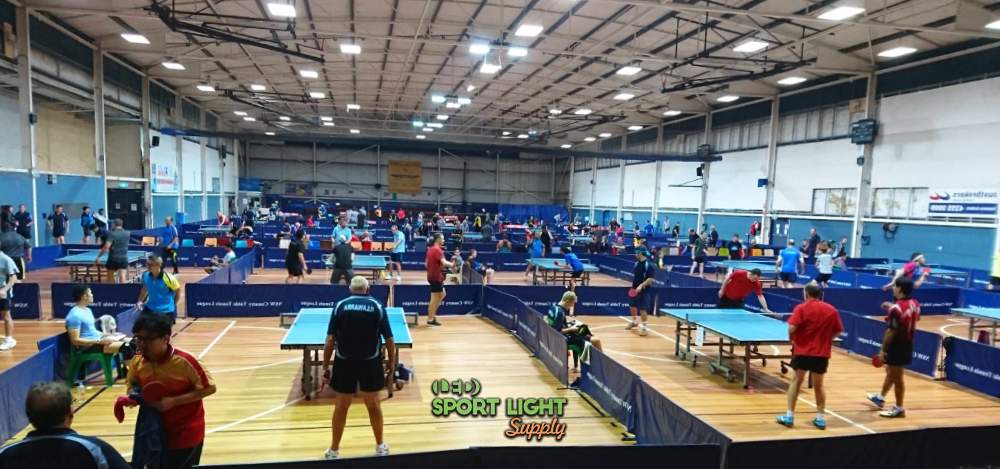
The quality and arrangement of lighting can significantly influence both the visual comfort and performance of players. When the lighting is improperly set up, it can result in visual discomfort, reduced accuracy, and increased fatigue. To ensure a high-quality playing experience, lighting should be carefully planned and tailored to meet specific needs. This guide explores the various factors that contribute to creating a well-lit table tennis room, focusing on LED lighting solutions, proper lighting levels, and strategies for reducing glare, among other aspects.

Table of Contents
ToggleIn any sports setting, including table tennis, the quality of the lighting can have a profound effect on how players perform. Adequate illumination is necessary not only for optimal gameplay but also to prevent strain on the eyes. Poor lighting can lead to difficulty in seeing the ball clearly, which is a major disadvantage in a fast-paced sport like table tennis. By ensuring the room is well-lit, players can better focus on the game, improving both their reaction times and accuracy.
Effective lighting also helps create a comfortable atmosphere for the players. In a room with inadequate light, players may feel fatigued more quickly, which can detract from their overall experience. Lighting that is too dim or harsh may cause eye strain, leading to discomfort and even headaches during extended play. A carefully considered lighting setup can help ensure that players maintain their energy levels and enjoy the game fully.
When it comes to lighting for sports environments like a table tennis room, LED lights are often the preferred choice. There are several advantages to using LED lighting over traditional light sources such as incandescent or fluorescent bulbs. The most significant benefits include energy efficiency, longevity, and the quality of light they provide. These features make LED lights an ideal option for spaces where consistent and clear illumination is necessary.
One of the biggest advantages of LED lighting is its energy efficiency. Compared to older technologies, LEDs consume far less energy to produce the same amount of light. This results in significant savings on electricity bills, which can be particularly important in a setting where the lights are often on for long periods. Moreover, LEDs last far longer than traditional bulbs, with some fixtures having a lifespan of 50,000 hours or more. This reduces the need for frequent replacements, saving both time and maintenance costs.
LED lights are known for their superior brightness and ability to maintain consistent light quality over time. Unlike traditional lighting solutions, which may flicker or degrade in intensity as they age, LEDs provide stable and uniform illumination. In a table tennis room, this is crucial for maintaining consistent visibility across the entire playing surface. The even distribution of light provided by LEDs ensures that there are no dark spots or areas with uneven lighting that could interfere with the game.

The amount of light required in a table tennis room is not the same as in other types of indoor spaces. A balance needs to be struck between brightness and comfort. The recommended illuminance level for a table tennis room typically falls within the range of 300 to 500 lux. This range ensures that the playing surface is adequately lit, with sufficient brightness to reduce shadows and prevent glare from interfering with the players’ focus.
| Activity | Recommended Lux Level (lux) | Uniformity Ratio | Description |
|---|---|---|---|
| General Play | 300-500 lux | 0.6 – 0.7 | Provides enough illumination for clear visibility without excessive shadows. |
| Competitive Play | 500 lux | 0.7 – 0.8 | Higher lux levels ensure clarity for fast movements and precise ball tracking. |
| Professional Tournaments | 750-1000 lux | 0.7 – 0.8 | Maximizes lighting for high-accuracy requirements and visibility. |
| Recreational Play (casual) | 300 lux | 0.5 – 0.6 | Suitable for leisure play, ensuring a comfortable and well-lit environment. |
| Training Sessions | 500 lux | 0.6 – 0.7 | Ideal for practice, offering good visibility while reducing visual strain. |
To achieve the ideal lux levels, it’s important to select the right type of fixtures and position them strategically. The fixtures should be chosen not only for their brightness but also for their ability to diffuse light evenly. LED fixtures can provide a wide and uniform spread of light, which helps prevent dark patches on the playing surface that could hinder visibility. Additionally, it’s essential to maintain the right balance of brightness in relation to other ambient light sources in the room, so the playing area is not over-illuminated, which could cause glare.
In a table tennis room, it is also important to control the intensity of the light. While bright lighting can be useful, it should not be overwhelming. Light that is too intense can lead to discomfort, causing players to squint or feel fatigued more quickly. Dimmer controls can be installed to adjust the lighting intensity according to the time of day, the level of activity, and personal preferences. This allows players to enjoy an optimal level of brightness throughout the game.
Another key element of lighting design for table tennis rooms is ensuring uniformity in light distribution. Uneven light distribution can create shadows or bright spots on the playing surface, which would interfere with a player’s ability to see the ball clearly. This could have a direct impact on the accuracy and flow of the game.
LED fixtures are particularly well-suited for providing even lighting across a large space. Thanks to their advanced design, these fixtures are capable of distributing light evenly across the playing area. When selecting LED lights for a table tennis room, it is important to opt for high-quality fixtures designed for uniform light output. These fixtures should be placed at strategic points to ensure that every part of the room, including the edges of the playing area, is illuminated without any noticeable differences in light intensity.
To achieve uniform lighting, fixtures should be placed with care. Ceiling-mounted panels or high-bay fixtures are often the best option for sports rooms because they provide wide coverage and can be installed at appropriate heights. It’s important to avoid the use of direct light sources that create sharp shadows, as these can hinder gameplay. Instead, lighting should be spread out evenly across the room, with the fixtures positioned at angles that minimize the creation of any dark zones.
Glare is a common problem in rooms with inadequate or poorly positioned lighting. Glare can make it difficult for players to focus on the game, as it creates uncomfortable visual distractions. In a fast-paced sport like table tennis, glare can be particularly disruptive, as players need to maintain a clear view of the ball at all times. To minimize glare, it is essential to carefully consider the placement and shielding of the lighting fixtures.
LED lights should be positioned in such a way that they do not shine directly into the players’ eyes. This can be achieved by angling the lights downwards or using diffusers that help spread the light more evenly. Additionally, the use of reflectors can help direct the light to where it’s needed without creating harsh reflections. Ceiling-mounted lights are often preferred in this regard, as they can be angled to ensure that the light is distributed across the entire surface without causing discomfort.
To further reduce glare, LED fixtures with diffusers and reflectors can be utilized. Diffusers help spread the light over a wider area, softening its intensity and ensuring a more even distribution. Reflectors are used to direct light in a controlled manner, minimizing the possibility of direct glare. Choosing LED fixtures with these features can create a more comfortable and visually appealing environment for players.

The color temperature of the lights in a table tennis room can influence the overall feel of the space. A color temperature in the range of 4000K to 5000K is ideal for maintaining a neutral or cool white light, which closely mimics natural daylight. This color temperature helps in maintaining accurate color perception and reducing eye strain, which is particularly beneficial during fast movements and quick decision-making.
In addition to color temperature, the Color Rendering Index (CRI) of the lighting is also an important factor to consider. LED lights with a high CRI value provide more accurate color reproduction, which can enhance visual comfort. A high CRI ensures that the colors of the ball, table, and surrounding environment are accurately rendered, making it easier for players to judge distances and the trajectory of the ball.
While 4000K to 5000K is ideal, it’s important to consider the specific needs of the players when choosing a color temperature. Cooler light (5000K) is often preferred in sports environments because it can enhance alertness and focus. A slightly warmer light (around 4000K) may provide a more relaxed atmosphere, but this can sometimes reduce visual clarity. It’s a matter of balancing brightness, comfort, and performance to find the most suitable color temperature for the space.
Beyond the immediate performance benefits, LED lighting also offers substantial energy savings. LED lights use far less power than traditional incandescent or fluorescent bulbs to produce the same amount of light. This efficiency reduces electricity consumption, which can have a significant impact on long-term operational costs, especially in sports environments where lights are often on for long periods.
The long lifespan of LED lights also means that they require less frequent maintenance or replacement, which can further reduce costs. LEDs are built to last for many years, unlike traditional bulbs, which may burn out or degrade more quickly. This is particularly advantageous for spaces like table tennis rooms that are in regular use. By investing in quality LED fixtures, facility owners can avoid the hassle and expense of constant bulb replacements.
The lighting in a table tennis room plays a major role in determining the quality of the playing experience. By selecting the right lighting solutions, such as energy-efficient LED fixtures, and ensuring proper placement and distribution, the room can be optimally lit to enhance both performance and comfort. Thoughtful lighting design can minimize glare, ensure even illumination, and support the visual demands of the game. Whether it’s through achieving the right lux levels, choosing the ideal color temperature, or reducing maintenance costs, the advantages of good lighting go far beyond simple visibility, contributing to a superior environment for players.
Drop us a line to receive a free lighting design